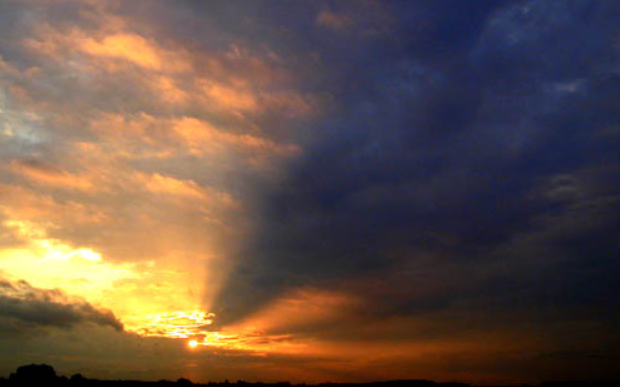Cloud Shadows
Cloud Shadows: The Enigmatic Beauty in the Sky
Cloud shadows, a captivating atmospheric phenomenon, have the power to transform the sky into a canvas of mesmerizing patterns and hues. These ethereal shadows, which are essentially the inverse of crepuscular rays, create dramatic effects that leave us in awe of nature's artistry. While their appearance may seem simple at first glance, there is a fascinating science behind these captivating displays.
The Nature of Cloud Shadows
Cloud shadows occur when a cloud blocks sunlight, casting a shadow onto the surrounding sky. This shadow can take various forms, ranging from elongated streaks to intricate patterns resembling brushstrokes on a celestial canvas. The shape and size of the cloud, as well as its position relative to the sun, determine the characteristics of the resulting shadow. The interplay between light and shadow creates a dynamic display that evolves as the cloud moves across the sky.
Factors Influencing Cloud Shadows
Several factors influence the appearance of cloud shadows, making each occurrence unique and captivating in its own way. These factors include:
-
Cloud Shape and Density: The shape and density of the cloud play a significant role in determining the shape and intensity of the resulting shadow. Fluffy, cumulus clouds may produce softer, more diffuse shadows, while denser and more substantial clouds can create darker and more defined shadows.
-
Sun Position: The position of the sun relative to the cloud influences the angle at which the shadow is cast. The lower the sun is in the sky, the longer and more elongated the shadow becomes. As the sun moves higher, the shadow shortens and may eventually disappear altogether.
-
Cloud Altitude: The altitude at which the cloud is located affects the size and shape of its shadow. Higher altitude clouds may cast larger shadows that cover a wider expanse of the sky, while lower altitude clouds may create smaller, more concentrated shadows.
The Dance of Light and Shadow
When a cloud shadow graces the sky, it creates a captivating dance of light and shadow. As sunlight filters through gaps in the cloud, it illuminates the surrounding sky, creating a striking contrast between the shadowed areas and the sunlit regions. This interplay between light and shadow adds depth and dimension to the sky, transforming it into a breathtaking spectacle.
Capturing the Beauty
Witnessing the ephemeral beauty of cloud shadows is a remarkable experience. To capture this spectacle, photographers often seek out vantage points that offer unobstructed views of the sky. By carefully framing the scene and adjusting camera settings, they can immortalize these fleeting moments, allowing others to appreciate the captivating beauty of cloud shadows.
Cloud Shadows in Art and Literature
Cloud shadows have inspired artists and writers throughout history. The ever-changing patterns and ethereal nature of these shadows have been depicted in paintings, poems, and literature. From the haunting landscapes of J.M.W. Turner to the evocative verses of William Wordsworth, cloud shadows have served as a muse for creative minds, inviting contemplation and reflection on the transient nature of existence.
Scientific Significance
Beyond their aesthetic appeal, cloud shadows also have scientific significance. They provide valuable insights into atmospheric conditions and cloud dynamics. By studying the behavior of cloud shadows, scientists can gain a better understanding of how clouds form, evolve, and interact with sunlight. This knowledge contributes to our understanding of weather patterns, climate change, and the Earth's overall atmospheric processes.
Conclusion
Cloud shadows are a testament to the enchanting beauty and complexity of our atmosphere. As these ethereal shadows grace the sky, they captivate our senses and remind us of the awe-inspiring wonders that surround us. By delving into the science behind cloud shadows and appreciating their artistic allure, we can deepen our connection with the natural world and gain a greater appreciation for the subtle intricacies that shape our daily lives. So, the next time you gaze at the sky and witness the dance of light and shadow, take a moment to revel in the enigmatic beauty of cloud shadows.

A distant cloud casts its shadow across the sky. Cloud shadows, in effect the inverse of crepuscular rays, can produce some dramatic effects. Photo © Lea Cowley
Note: this article has been automatically converted from the old site and may not appear as intended. You can find the original article here.
Reference Atmospheric Optics
If you use any of the definitions, information, or data presented on Atmospheric Optics, please copy the link or reference below to properly credit us as the reference source. Thank you!
-
<a href="https://atoptics.co.uk/blog/cloud-shadows/">Cloud Shadows</a>
-
"Cloud Shadows". Atmospheric Optics. Accessed on December 18, 2024. https://atoptics.co.uk/blog/cloud-shadows/.
-
"Cloud Shadows". Atmospheric Optics, https://atoptics.co.uk/blog/cloud-shadows/. Accessed 18 December, 2024
-
Cloud Shadows. Atmospheric Optics. Retrieved from https://atoptics.co.uk/blog/cloud-shadows/.